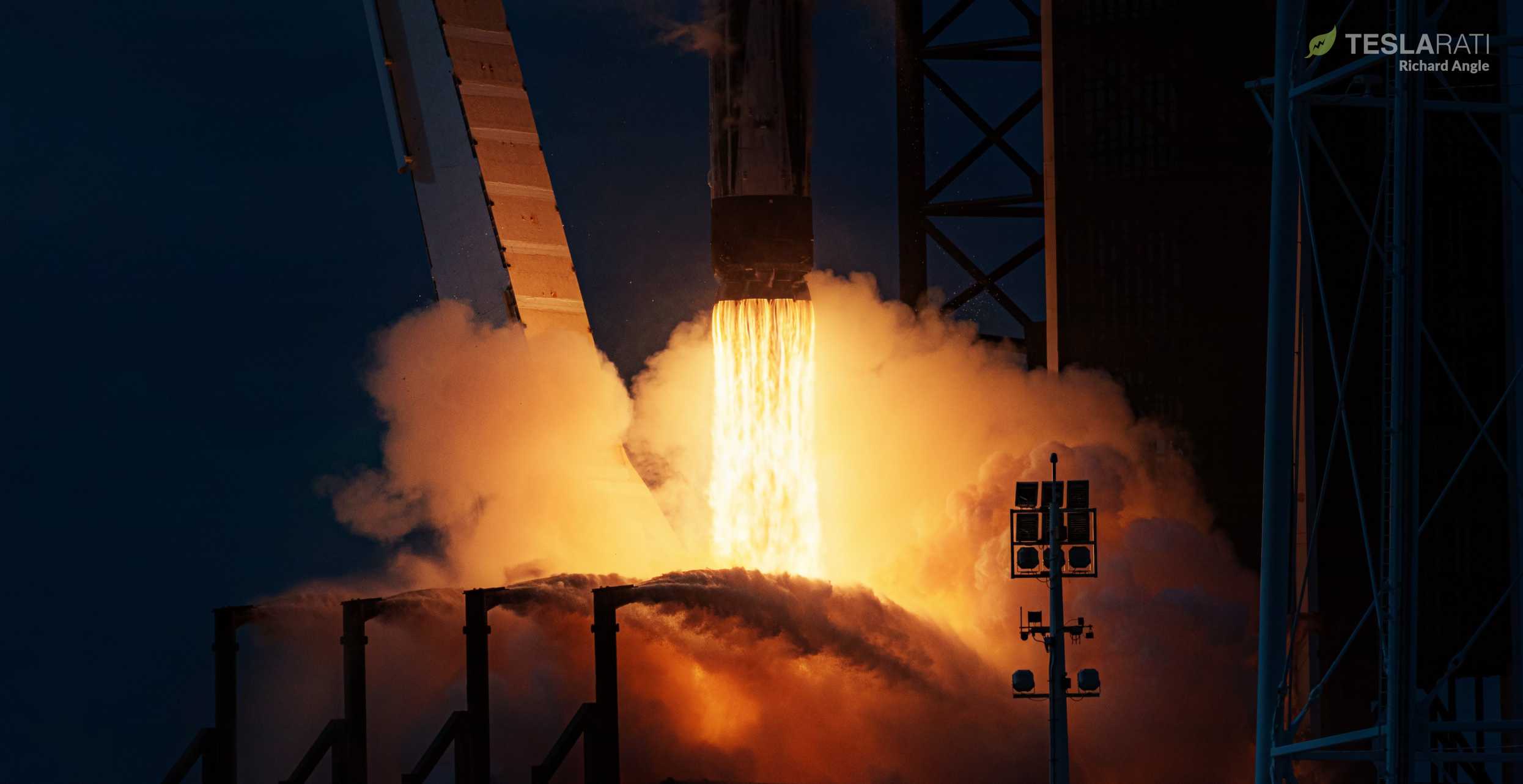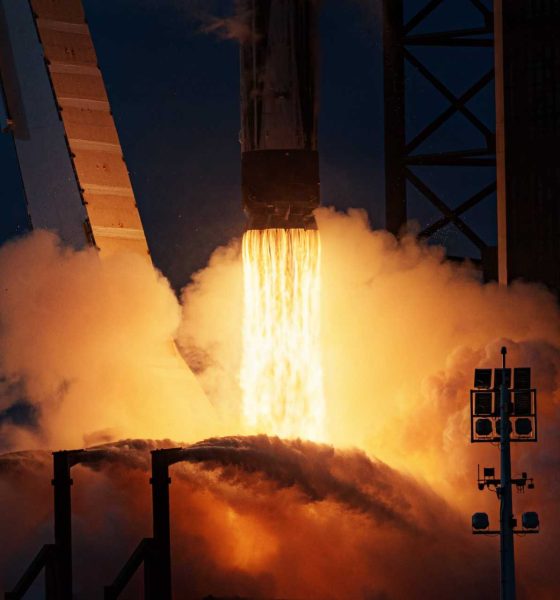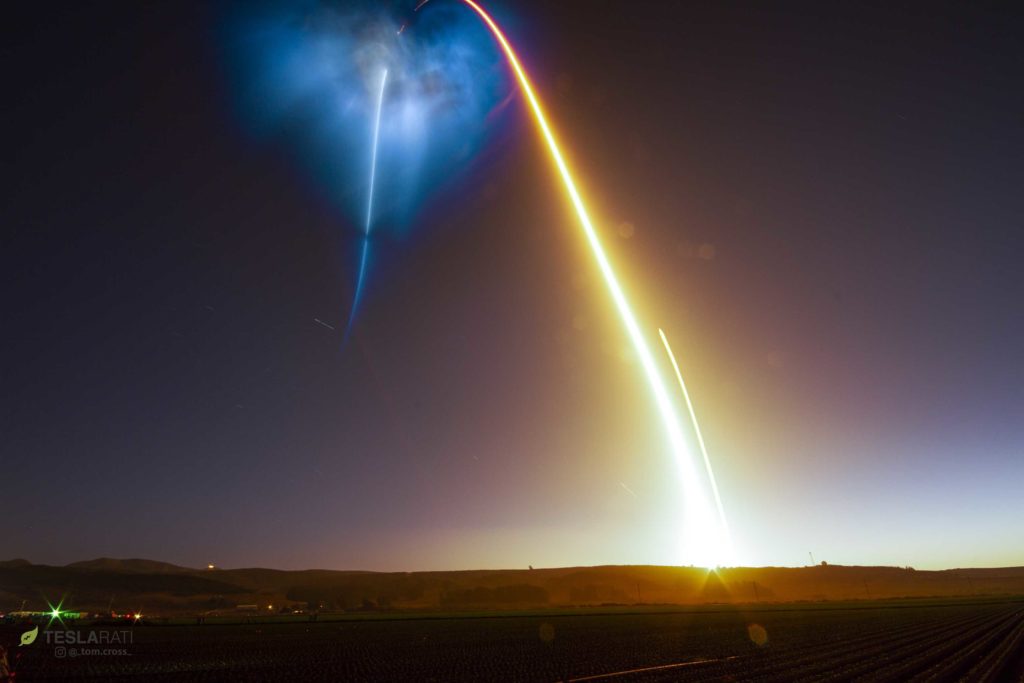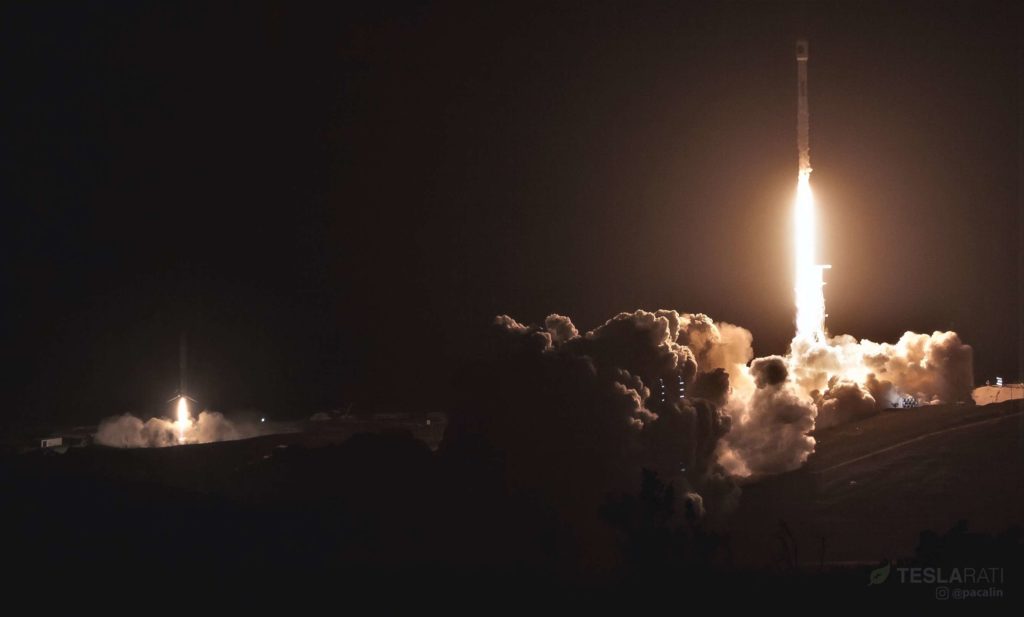

News
SpaceX sets date for first Florida launch of its kind in more than half a century
Argentinian space agency CONAE says that both its SAOCOM 1B satellite and SpaceX are on track for a type of launch that the United States’ East Coast hasn’t supported in more than half a century.
CONAE has revealed that SpaceX aims to launch the ~2800 kg (6200 lb) radar Earth observation satellite into orbit on a Falcon 9 rocket as early as March 30th, 2020 – late next month. With such a light payload, the Falcon 9 booster – presumably reused – will be able to perform a Return to Launch Site (RTLS) recovery, touching down at one of SpaceX’s two Landing Zone (LZ) pads located at Cape Canaveral Air Force Station (CCAFS). While Landing Zone rocket recoveries have become increasingly rare for SpaceX, that’s not actually why the SAOCOM 1B mission is so unique.
Instead, it’s exceptional because it will be the United States’ first East Coast polar launch in nearly six decades. The mission’s “polar” launch profile refers to the fact that the Argentinian radar satellite will ultimately orbit Earth’s poles, effectively perpendicular to more common equatorial orbits. If successful and repeatable, the mission could ultimately spark a new era for CCAFS and Kennedy Space Center (KSC) and raises big questions about the future of California’s Vandenberg Air Force Base (VAFB) — or at least SpaceX’s presence there.
Previously discussed on Teslarati late last year, the story behind why Cape Canaveral stopped polar launches is quite a weird one. A 2008 article in the Naval History Magazine sums up the events nicely.
“In what somewhat inaccurately became known as “the herd shot around the world,” some..falling rocket debris apparently splattered on a Cuban farm and killed a cow. “This is a Yankee provocation,” accused Revolucion, an official Cuban publication, insisting that the rocket was deliberately exploded over the country. Government radio stations cited the incident as further proof that the United States was trying to destroy the regime of Cuban President Fidel Castro. One cow was even paraded in front of the U.S. Embassy in Havana wearing a placard reading “Eisenhower, you murdered one of my sisters.”
Castro filed a complaint at the United Nations, and Washington sheepishly conceded the possibility that “fragments from the rocket booster” could have landed in Cuba. CIA Director George Tenet later quipped somewhat tastelessly that it was “the first, and last, time that a satellite had been used in the production of ground beef.” Further launches overflying Cuba were postponed, and improvements were made to the Cape Canaveral range-safety system. In any case, it was a dejected NRL group that returned to Washington.”
Naval History Magazine – April 2008
That November 1960 launch thus shut down East Coast polar launches to avoid overflying Cuba and raising the country’s ire near the height of Cold War tensions. It’s believed that the Cape actually launched two more semi-polar missions in the mid-1960s, some five years later, but the fact remains that SpaceX’s prospective March 30th, 2020 launch will mark the United States’ first East Coast launch in more than half a century.

Back in October 2019, while SpaceX had effectively confirmed that it would try to move SAOCOM 1B’s launch from California to Cape Canaveral, CCAFS hadn’t fully approved the change or literally reopened the East Coast’s polar launch corridor. Now, given that CONAE has officially announced a specific launch date (March 30th), it seems safe to say that CCAFS has fully given SpaceX the go-ahead for the launch.
While Falcon 9’s upper stage will still technically overfly Cuba over the course of the launch, the combination of a rare ‘dogleg’ maneuver shortly after launch and the fact that said upper stage will be far above the Earth’s surface have effectively mitigated any technical or legal showstoppers. Around eight minutes after liftoff, the mission’s Falcon 9 booster will also attempt to return to Florida and land at SpaceX’s LZ-1 or 2 landing pad. SpaceX’s October 2018 Vandenberg Air Force Base (VAFB) SAOCOM 1A launch coincidentally marked the first-ever use of Landing Zone-4 (LZ-4), a dedicated landing pad built for SpaceX’s West Coast launch site.

If successful, a polar Falcon 9 launch from Cape Canaveral also raises the question: if SpaceX can potentially perform all conceivable launch profiles from its two Florida pads, why go the effort and expense of maintaining a third pad – entirely dedicated to polar launches – in California? Aside from one lone launch six months later, SpaceX’s last California launch occurred in January 2019 and the next one is expected no earlier than November 2020 – and could very well never happen at all. The only plausible reasons to continue launching from SpaceX’s Vandenberg pad would be if Florida’s polar capabilities were somehow limited or if conservative, bureaucratic customers like NASA and the US military were dead-set on their polar missions only launching from semi-arbitrarily selected launch pads.
Without any modifications whatsoever, Falcon Heavy could also immediately begin performing polar launches from Cape Canaveral, whereas SpaceX would likely need tens of millions of dollars and 6-12 months to modify its California pad to support the massive rocket. Perhaps keeping that pad quietly mothballed and flying launch staff in from Florida and Texas for occasional missions is a much smaller ordeal than it seems. Still, the allure (and efficiency) of a one-stop-launch-shop at Cape Canaveral is almost certainly hard to ignore for a company like SpaceX.
For the SAOCOM 1B launch, the next milestone will be the Argentinian satellite’s arrival at SpaceX’s Florida payload processing facilities, likely to occur within the next week. Already, March is lining up to be an exceptionally busy month for SpaceX, with two separate Falcon 9 launches currently scheduled on March 2nd and March 4th and another Starlink mission likely later in the month. With a little luck, SpaceX might be able to end Q1 2020 with its first four-launch month ever.
Check out Teslarati’s Marketplace! We offer Tesla accessories, including for the Tesla Cybertruck and Tesla Model 3.

News
Tesla China delivery centers look packed as 2025 comes to a close
Needless to say, it appears that Tesla China seems intent on ending 2025 on a strong note.

Tesla’s delivery centers in China seem to be absolutely packed as the final days of 2025 wind down, with photos on social media showing delivery locations being filled wall-to-wall with vehicles waiting for their new owners.
Needless to say, it appears that Tesla China seems intent on ending 2025 on a strong note.
Full delivery center hints at year-end demand surge
A recent image from a Chinese delivery center posted by industry watcher @Tslachan on X revealed rows upon rows of freshly prepared Model Y and Model 3 units, some of which were adorned with red bows and teddy bears. Some customers also seem to be looking over their vehicles with Tesla delivery staff.
The images hint at a strong year-end push to clear inventory and deliver as many vehicles as possible. Interestingly enough, several Model Y L vehicles could be seen in the photos, hinting at the demand for the extended wheelbase-six seat variant of the best-selling all-electric crossover.
Strong demand in China
Consumer demand for the Model Y and Model 3 in China seems to be quite notable. This could be inferred from the estimated delivery dates for the Model 3 and Model Y, which have been extended to February 2026 for several variants. Apart from this, the Model Y and Model 3 also continue to rank well in China’s premium EV segment.
From January to November alone, the Model Y took China’s number one spot in the RMB 200,000-RMB 300,000 segment for electric vehicles, selling 359,463 units. The Model 3 sedan took third place, selling 172,392. This is quite impressive considering that both the Model Y and Model 3 are still priced at a premium compared to some of their rivals, such as the Xiaomi SU7 and YU7.
With delivery centers in December being quite busy, it does seem like Tesla China will end the year on a strong note once more.
News
Tesla Giga Berlin draws “red line” over IG Metall union’s 35-hour week demands
Factory manager André Thierig has drawn a “red line” against reducing Giga Berlin’s workweek to 35 hours, while highlighting that Tesla has actually increased its workers’ salaries more substantially than other carmakers in the country.

Tesla Giga Berlin has found itself in a new labor dispute in Germany, where union IG Metall is pushing for adoption of a collective agreement to boost wages and implement changes, such as a 35-hour workweek.
In a comment, Giga Berlin manager André Thierig drew a “red line” against reducing Giga Berlin’s workweek to 35 hours, while highlighting that Tesla has actually increased its workers’ salaries more substantially than other carmakers in the country.
Tesla factory manager’s “red line”
Tesla Germany is expected to hold a works council election in 2026, which André Thierig considers very important. As per the Giga Berlin plant manager, Giga Berlin’s plant expansion plans might be put on hold if the election favors the union. He also spoke against some of the changes that IG Metall is seeking to implement in the factory, like a 35-hour week, as noted in an rbb24 report.
“The discussion about a 35-hour week is a red line for me. We will not cross it,” Theirig said.
“(The election) will determine whether we can continue our successful path in the future in an independent, flexible, and unbureaucratic manner. Personally, I cannot imagine that the decision-makers in the USA will continue to push ahead with the factory expansion if the election results favor IG Metall.”
Giga Berlin’s wage increase
IG Metall district manager Jan Otto told the German news agency DPA that without a collective agreement, Tesla’s wages remain significantly below levels at other German car factories. He noted the company excuses this by referencing its lowest pay grade, but added: “The two lowest pay grades are not even used in car factories.”
In response, Tesla noted that it has raised the wages of Gigafactory Berlin’s workers more than their German competitors. Thierig noted that with a collective agreement, Giga Berlin’s workers would have seen a 2% wage increase this year. But thanks to Tesla not being unionized, Gigafactory Berlin workers were able to receive a 4% increase, as noted in a CarUp report.
“There was a wage increase of 2% this year in the current collective agreement. Because we are in a different economic situation than the industry as a whole, we were able to double the wages – by 4%. Since production started, this corresponds to a wage increase of more than 25% in less than four years,” Thierig stated.
News
Tesla is seeing a lot of momentum from young Koreans in their 20s-30s: report
From January to November, young buyers purchased over 21,000 Teslas, putting it far ahead of fellow imported rivals like BMW and Mercedes-Benz.

Tesla has captured the hearts of South Korea’s 20s-30s demographic, emerging as the group’s top-selling imported car brand in 2025. From January to November, young buyers purchased over 21,000 Teslas, putting it far ahead of fellow imported rivals like BMW and Mercedes-Benz.
Industry experts cited by The Economist attributed this “Tesla frenzy” to fandom culture, where buyers prioritize the brand over traditional car attributes, similar to snapping up the latest iPhone.
Model Y dominates among young buyers
Data from the Korea Imported Automobile Association showed that Tesla sold 21,757 vehicles to the 20s-30s demographic through November, compared to BMW’s 13,666 and Mercedes-Benz’s 6,983. The Model Y led the list overwhelmingly, with variants like the standard and Long Range models topping purchases for both young men and women.
Young men bought around 16,000 Teslas, mostly Model Y (over 15,000 units), followed by Model 3. Young women followed a similar pattern, favoring Model Y (3,888 units) and Model 3 (1,083 units). The Cybertruck saw minimal sales in this group.
The Model Y’s appeal lies in its family-friendly SUV design, 400-500 km range, quick acceleration, and spacious cargo, which is ideal for commuting and leisure. The Model 3, on the other hand, serves as an accessible entry point with lower pricing, which is valuable considering the country’s EV subsidies.
The Tesla boom
Experts described Tesla’s popularity as “fandom culture,” where young buyers embrace the brand despite criticisms from skeptics. Professor Lee Ho-geun called Tesla a “typical early adopter brand,” comparing purchases to iPhones.
Professor Kim Pil-soo noted that young people view Tesla more as a gadget than a car, and they are likely drawn by marketing, subsidies, and perceived value. They also tend to overlook news of numerous recalls, which are mostly over-the-air software updates, and controversies tied to the company.
Tesla’s position as Korea’s top import for 2025 seems secured. As noted by the publication, Tesla’s December sales figures have not been reported yet, but market analysts have suggested that Tesla has all but secured the top spot among the country’s imported cars this year.








